Introduction to labour and birthing positions
The best position for women to adopt during labour and birth varies depending on which stage of labour she is in. There are three stages of labour. The first stage of labour is from the beginning of the contractions that cause the cervix (the opening of the womb) to open (dilate), until the cervix is fully dilated. The second stage is when the cervix is fully dilated and the woman can start pushing the baby out. The third stage is after the baby has been born, and the placenta is delivered.
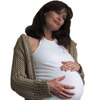 |
For more information, see Stages of Labour. |
First stage of labour
There are many options for women when deciding which position is best during the first stage of their labour. Research attempting to compare positions in terms of outcomes for mothers and babies has been limited. Women instinctively use a variety of positions and movements to cope with the pain of the first stage of labour. These include walking, leaning forward, gentle lunging, four-point kneeling (kneeling on hands and feet), rocking and swaying. The act of changing positions may give women a sense of control by providing something active they can do to relieve the sense of feeling overwhelmed during labour.
Upright positions and keeping moving

- Likelihood of requiring a caesarian delivery;
- Likelihood of assisted delivery such as augmentation (oxytocin drip);
- Likelihood of instrumental delivery (forceps, vacuum);
- Length of the second stage; or
- Requirement for strong pain relief medicines.
Women who go through the first stage in an upright position are less likely to require an epidural. Some studies have found that for women without epidurals, walking around or being seated upright (e.g. on a birthing ball) may shorten the first stage of labour by approximately one hour, although these findings have not been consistent. The shortened labour is likely due to the increased pressure of the baby’s head on the cervix, causing it to dilate.
Spending at least 30 minutes during labour in four-point kneeling, possibly with pillows under the knees and hands, has been found to reduce persistent back pain during labour. However, this position does not help the baby to rotate from a posterior position (where the baby’s face is toward the front of a woman’s body when it is delivered, which can be more difficult) to an anterior position (where the baby’s face is toward the back of the woman’s body when it is delivered), or affect the need for caesarean delivery, rates of perineal tears, Apgar scores (which measure the wellbeing of the baby when it is born), or length of labour. Nevertheless, most women find it an acceptable position for labouring.
Moving around, sitting in a chair or on a ball, showering and baths may also reduce discomfort during contractions. Being seated in an upright position during cervical dilation from 6 to 8 centimetres results in less back pain than lying on the back. Walking around has not been found to alter the need for augmentation, use of painkillers, or requirement for assisted or caesarean delivery.
The appropriateness of such activities varies depending on factors such as the need to monitor the mother and baby, personal preference, and epidural anaesthesia.As there is no significant effect of posture on labour progress, women will be encouraged to assume the position in which they are most comfortable, and as long as there are no complications, women should be free to walk around if they so wish.
Once labour is well established, the strength of contractions may be such that moving around becomes more difficult. The midwife and birth attendant will help the woman find a position in which she feels comfortable. The woman should be supported by attendants, pillows, furniture and the like, in order to allow her to relax as much as possible. Bent knees allow pelvic rocking to take place, and reduce strain on the joints, while legs wide apart increase the base of support, and allow an ‘open’ pelvic position.
Non-upright positions
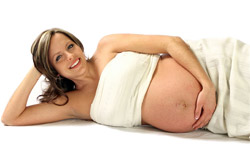
When a pregnant woman is lying on her back, the weight of the baby and uterus presses on the large blood vessels in the abdomen, which may reduce the blood supply to the baby and uterus, and decrease the strength of the contractions. Putting a wedge under one hip can help reduce this effect. Little is known about the effect of upright versus lying down positions during the first stage on outcomes for babies or satisfaction for mothers. In general, the woman should do whatever makes her feel most comfortable during the first stage, although she will need to take into account advice from her doctor or midwife regarding her and her child’s wellbeing, and the need for close monitoring.
Although some women with epidural anaesthesia are able to walk around safely, if a woman has an epidural or spinal anaesthetic that has resulted in muscle weakness or problems with blood pressure, she will not be able to move around until it wears off. If the epidural has partly blocked feeling, but not movement, the woman may still be able to remain mobile and upright.
Lying flat on the back (supine) will reduce a pregnant woman’s blood supply to her baby, and studies have found that less oxygen reaches the baby as a result. Side-lying or a half-lying positioning with pillows or a wedge under one hip will improve blood supply to the baby.
During the transition phase, standing or sitting in the shower with water directed towards the back or the abdomen may help with pain control. Two-point or four-point kneeling, with the woman well supported on a beanbag or pillows, may also assist with this stage. If a premature urge to push occurs, the knee–chest position has been suggested. This is where the woman kneels with her forehead and arms on the floor and her bottom in the air, in order to reduce pressure on her cervix.
Water immersion
Being immersed in water such as a bath or birth pool during the first stage of labour significantly reduces perception of pain and use of epidural analgesia. It does not have any negative effects on length of labour, operative delivery rates, or wellbeing of the baby.
Positions for first stage
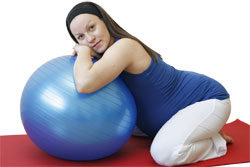
Upright positions
- Standing: Leaning onto a benchtop or similar surface, or the back of a chair, or leaning on a partner with hands around their neck or waist for contractions may be helpful. Some women find asymmetrical positions reduce discomfort, such as having one leg bent with the foot on a stool;
- Sitting, usually with the legs wide apart, leaning forward with elbows on thighs. Alternatively, straddling a chair, resting forward on pillows on the backrest, may be helpful, especially to relieve back pain. Again, asymmetrical positions may be helpful, with one leg up on the lounge and the other on the floor. Rocking chairs, or swaying with the bottom on a large ball, may provide comfort;
- Kneeling, possibly with a pillow between the bottom and the feet, and leaning forwards onto a bed (hospital beds may have the head raised to lean against), beanbag or chair seat;
- Walking around, although it is important that the woman conserves her energy, so taking rests regularly are encouraged.
Non-upright positions
- Four-point kneeling, in which the abdomen is hanging freely, and the hips are over the shoulders. Weight may be taken alternately between the hands and the forearms resting on a raised surface. This position has been found to be appropriate for most women with epidural anaesthesia;
- Side-lying for rest, with pillows between the legs for comfort; and
- Recumbent or semi-recumbent, though the impact on blood supply to the baby needs to be taken into account.
Second stage of labour
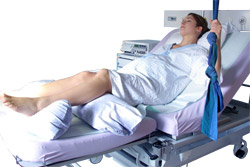
History of birthing positions
In traditional societies, where the influence of ‘Western medicine’ is limited, women in labour tend to move around and change positions freely, and avoid assuming lying down positions. They tend to have support in an upright position through devices such as slings, birthing stools, rope and attendants. They are encouraged to rock or circle their pelvis, or shift weight between their feet. If required, they may briefly spend time in a side-lying position. Prior to the 1700s, women in Western countries also tended to deliver in upright positions. Over the past 300 years or so, women in Western society have been encouraged to deliver in lying down positions, largely for the convenience of the doctor or midwife delivering the baby.
Upright versus non-upright positions for delivery
Many women continue to deliver in a non-upright position, although there is increasing support for consideration of delivering in an upright position. Advantages of delivering in an upright position are not proven, but are thought to include:
- Assistance of gravity helping passage of the baby through the birth canal;
- Decreased compression of the blood vessels in the abdomen, improving the strength and efficiency of contractions;
- Improved alignment of the baby with the passage through the birth canal, thus allowing the woman to ‘bear down’ in the direction of the baby’s movement; and
- Increased width of pelvic outlet.
Studies comparing different birth positions are not of good quality. However, it has been found that for women without epidurals, delivering in an upright position:
- Is less painful for the woman;
- Is associated with fewer abnormalities in the baby’s heartbeat;
- Results in slightly earlier delivery than non-upright positions;
- Reduces the likelihood of assisted delivery with forceps and episiotomy;
- Increases blood loss from the mother, though this finding may be related to the increased ease of collection of blood in an upright position; and
- Increases the rate and severity of perineal tears.
A study carried out in a country where women commonly use a deep squatting position for work, rest and toileting found no difference in use of episiotomies. However, there was a greater occurrence of perineal tears and use of instrumental delivery when women delivered in the lithotomy position (lying on the back with the legs in stirrups) versus in squatting. There was no difference in the health of the babies between the groups. Although the squatting position may assist delivery, Western women tend to be unaccustomed to maintaining a deep squatting position, so only a very small proportion of women are able to maintain this position for any meaningful length of time, or for delivery itself.
A large study showed the best position for avoiding perineal tears is in the lateral position. This is when the woman is lying on her side with the top leg supported by an attendant (66.6% avoided tears). Squatting was the position most commonly associated with tears (42% avoided tears). Birthing chairs have been used in several studies, and have been found to have no advantage in terms of length of the second stage, need for instrumental delivery or the degree of perineal trauma; however, they are associated with increased blood loss from the mother.
Influences on choice of position

There is a large range of choices of position and experience of pain in relation to position type. Women are most familiar with the supine position (lying on their backs), regardless of their ethnic background, which emphasises the importance of women learning about different positions during pregnancy and labour in order to increase their range of choices. The best place for a woman to learn about different options for labour is from her midwife or obstetrician, who will have suggestions and preferences that will help women prepare before birth. A Dutch study found that highly educated and older women were more likely to use birthing positions other than supine (lying on their back). Being able to choose her own birthing position increases a woman’s sense of control over the experience, and perception of the birth.
In all positions, the chin should be tucked in and the back rounded in order to maximise the efficiency of pushing. The midwife or obstetrician may encourage the woman to change position during the second stage, as this can help prevent injuries caused by long periods of pushing down in the one posture. There is limited information about the effect of position on outcomes for mothers and babies when the mother has an epidural.
If there is an increased risk of complications with a delivery (multiple births, large baby, etc), it may be most appropriate for delivery to take place in the lithotomy position, which is where the woman is lying on her back with her legs raised in stirrups, so that the attendant can easily see the perineum and access it if required. Otherwise, the mother may deliver the baby in almost any position she finds comfortable. In general, positions where the legs are wide apart and the hips are flexed maximise the width of the pelvis and assist passage of the baby. When delivery is very rapid, adopting a gravity-neutral position (four-point kneeling, sidelining) may help slow the stretch of the perineum and reduce the risk of tears.
Positions for second stage
Examples of positions that may be assumed for second stage include:
Upright positions
- Partial sitting / half-lying: Trunk tilted backwards approximately thirty decrees to the vertical. Pillows may be behind the knees, arms and back. During contractions, the woman may brace by holding her knees and pulling up. The partner may sit behind the woman to assist with pulling her knees up. The benefit of the semi-sitting position is that the perineum can be easily visualised and is accessible if necessary, though in one study this position was associated with an increased risk of perineal tears;
- Sitting, such as on a toilet or birth stool, with the legs wide apart and leaning forwards with the arms supported on the thighs, or by a partner;
- Kneeling, on the bed or floor, leaning against a large pile of pillows, or supported by a partner. Some women may feel more comfortable with one knee up; or
- Squatting, supported by partner behind, or holding onto a bar. The woman should stand to rest between contractions. This may not be appropriate for women who have had epidurals.
Non-upright positions
- Lying on the side, also known as the lateral, or ‘Sims’ position, with an attendant supporting the top leg. This is a good position when delivery is rapid, as it is gravity-neutral;
- Four-point kneeling, which may reduce the effect of gravity on delivery as the head is crowning, reducing the risk of perineal tears, and be more comfortable for women who are experiencing significant back pain.
Kindly written by:
Dr Merrilyn Booth MBBS(Hons) PSc(Physio)(Hons)
Doctor, Physiotherapist and Editorial Advisory Board Member of the Virtual Medical Centre.
More information
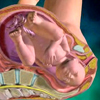 |
For more information on birth, including information about the stages of birth, birthing types, and helpful videos, see Birth. |
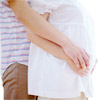 |
For more information about pregnancy, including preconception advice, stages of pregnancy, investigations, complications, living with pregnancy and birth, see Pregnancy. |
References
- Gupta JK, Nikodem C. Maternal posture in labour. Eur J Obstet Gynecol Reprod Biol. 2000;92(2):273–7. [Abstract]
- Romano AM, Lothian JA. Promoting, Promoting, protecting, and supporting normal birth: A look at the evidence. J Obstet Gynecol Neonatal Nurs. 2008;37(1):94-104. [Abstract]
- Simkin PP, O’hara M. Nonpharmacologic relief of pain during labor: Systematic reviews of five methods. Am J Obstet Gynecol. 2002;186(5 Suppl):S131-59. [Abstract]
- Berghella V, Baxter JK, Chauhan SP. Evidence-based labor and delivery management. Am J Obstet Gynecol. 2008;199(5):445-54. [Abstract | Full text]
- Lawrence A, Lewis L, Hofmeyr GJ, et al. Maternal positions and mobility during first stage labour. Cochrane Database Syst Rev. 2009;(2):CD003934. [Abstract | Full text]
- Bloom SL, McIntire DD, Kelly MA, et al. Lack of effect of walking on labor and delivery. N Engl J Med. 1998;339(2):76-9. [Abstract | Full text]
- Roberts CL, Algert CS, Olive E. Impact of first-stage ambulation on mode of delivery among women with epidural analgesia. Aust N Z J Obstet Gynaecol. 2004;44(6):489-94. [Abstract]
- Zwelling E. Overcoming the challenges: Maternal movement and positioning to facilitate labor progress. Am J Maternal Child Nurs. 2010;35(2):72-8. [Abstract]
- Hunter S, Hofmeyr GJ, Kulier R. Hands and knees posture in late pregnancy or labour for fetal malposition (lateral or posterior). Cochrane Database Syst Rev. 2007;(4):CD001063. [Abstract | Full text]
- Stremler R, Hodnett E, Petryshen P, et al. Randomized controlled trial of hands-and-knees positioning for occipitoposterior position in labor. Birth. 2005;32(4):243-51. [Abstract]
- RCOG statement on maternal position during the first stage of labour [online]. London: Royal College of Obstetricians and Gynaecologists; 15 April 2009 [cited 25 January 2010]. Available from: URL link
- Cluett ER, Burns E. Immersion in water in labour and birth. Cochrane Database Syst Rev. 2009;(2):CD000111. [Abstract | Full text]
- Adachi K, Shimada M, Usui A. The relationship between the parturient’s positions and perceptions of labor pain intensity. Nurs Res. 2003;52(1):47-51. [Abstract]
- Aldrich CJ, D’Antona D, Spencer JA, et al. The effect of maternal posture on fetal cerebral oxygenation during labour. Br J Obstet Gynaecol. 1995;102(1):14-9. [Abstract]
- Stremler R, Halpern S, Weston J, et al. Hands-and-knees positioning during labor with epidural analgesia. J Obstet Gynecol Neonatal Nurs. 2009;38(4):391-8. [Abstract]
- Gupta JK, Hofmeyr GJ, Smyth RMD. Position in the second stage of labour for women without epidural anaesthesia. Cochrane Database Syst Rev. 2005;(3):CD002006. [Abstract | Full text]
- Hastening the hour of deliverance. In: Gélis J (transl. Morris R). History of Childbirth: Fertility, pregnancy and birth in early modern Europe. [L’arbre et le Fruit: La naissance dans l’Occident moderne, XVIe-XIXe siècle. Paris: Libraire Arthème Fayard; 1984]. Cambridge: Polity Press; 1991: 112-33. [Book]
- Nasir A. Korejo R. Noorani KJ. Child birth in squatting position. J Pak Med Assoc. 2007;57(1):19-22. [Abstract | Full text]
- Racinet C. Maternal posture during parturition [in French]. Gynecol Obstet Fertil. 2005;33(7-8):533-8. [Abstract]
- Scholz HS, Benedicic C, Arikan MG, et al. Spontaneous vaginal delivery in the birth-chair versus in the conventional dorsal position: A matched controlled comparison. Wien Klin Wochenschr. 2001;113(17-18):695-7. [Abstract]
- Roberts J, Hanson L. Best practices in second stage labor care: Maternal bearing down and positioning. J Midwifery Womens Health. 2007;52(3):238-45. [Abstract]
- Roberts CL, Algert CS, Cameron CA, Torvaldsen S. A meta-analysis of upright positions in the second stage to reduce instrumental deliveries in women with epidural analgesia. Acta Obstet Gynecol Scand. 2005;84(8):794-8. [Abstract]
- Bodner-Adler B, Bodner K, Kimberger O, et al. Women’s position during labour: influence on maternal and neonatal outcome. Wien Klin Wochenschr. 2003;115(19-20):720-3. [Abstract]
- Ragnar I, Altman D, Tydén T, Olsson SE. Comparison of the maternal experience and duration of labour in two upright delivery positions: A randomised controlled trial. Br J Obstet Gynaecol. 2006;113(2):165-70. [Abstract | Full text]
- Shorten A, Donsante J, Shorten B. Birth position, accoucheur, and perineal outcomes: informing women about choices for vaginal birth. Birth. 2002;29(1):18-27. [Abstract | Full text]
- De Jonge A, Lagro-Janssen AL. Birthing positions: A qualitative study into the views of women about various birthing positions. J Psychosom Obstet Gynaecol. 2004;25(1):47-55. [Abstract]
- de Jonge A, Rijnders ME, van Diem MT, et al. Are there inequalities in choice of birthing position? Sociodemographic and labour factors associated with the supine position during the second stage of labour. Midwifery. 2009;25(4):439-48. [Abstract]
- Soong B, Barnes M. Maternal position at midwife-attended birth and perineal trauma: Is there an association? Birth. 2005;32(3):164-9. [Abstract]
- Shermer RH, Raines DA. Positioning during the second stage of labor: Moving back to basics. J Obstet Gynecol Neonatal Nurs. 1997;26(6):727-34. [Abstract]
All content and media on the HealthEngine Blog is created and published online for informational purposes only. It is not intended to be a substitute for professional medical advice and should not be relied on as health or personal advice. Always seek the guidance of your doctor or other qualified health professional with any questions you may have regarding your health or a medical condition. Never disregard the advice of a medical professional, or delay in seeking it because of something you have read on this Website. If you think you may have a medical emergency, call your doctor, go to the nearest hospital emergency department, or call the emergency services immediately.







